Diagnosis of Heart Failure Assesment Report
VerifiedAdded on 2022/08/27
|7
|1318
|14
AI Summary
Contribute Materials
Your contribution can guide someone’s learning journey. Share your
documents today.
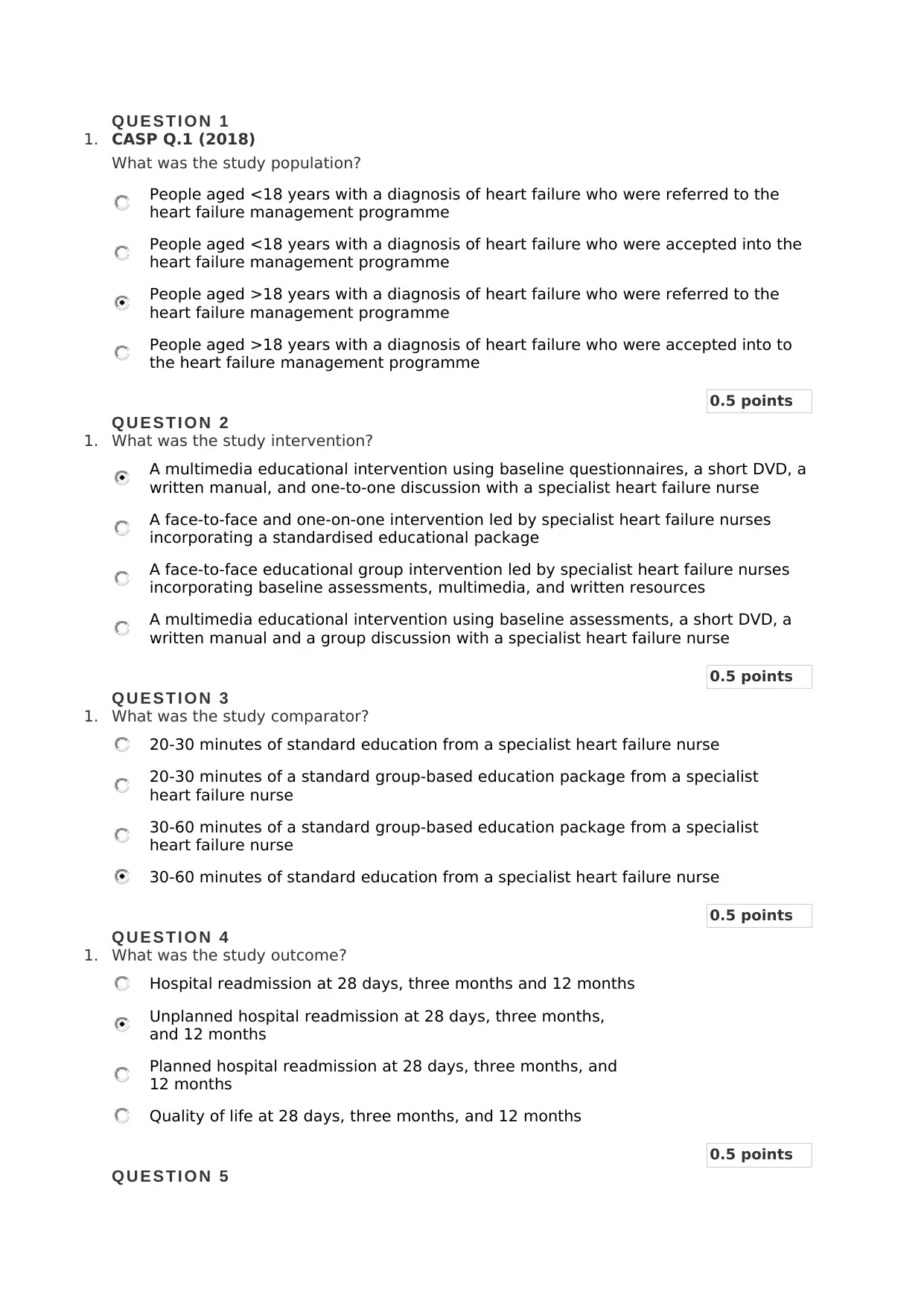
Q U E S T I O N 1
1. CASP Q.1 (2018)
What was the study population?
People aged <18 years with a diagnosis of heart failure who were referred to the
heart failure management programme
People aged <18 years with a diagnosis of heart failure who were accepted into the
heart failure management programme
People aged >18 years with a diagnosis of heart failure who were referred to the
heart failure management programme
People aged >18 years with a diagnosis of heart failure who were accepted into to
the heart failure management programme
0.5 points
Q U E S T I O N 2
1. What was the study intervention?
A multimedia educational intervention using baseline questionnaires, a short DVD, a
written manual, and one-to-one discussion with a specialist heart failure nurse
A face-to-face and one-on-one intervention led by specialist heart failure nurses
incorporating a standardised educational package
A face-to-face educational group intervention led by specialist heart failure nurses
incorporating baseline assessments, multimedia, and written resources
A multimedia educational intervention using baseline assessments, a short DVD, a
written manual and a group discussion with a specialist heart failure nurse
0.5 points
Q U E S T I O N 3
1. What was the study comparator?
20-30 minutes of standard education from a specialist heart failure nurse
20-30 minutes of a standard group-based education package from a specialist
heart failure nurse
30-60 minutes of a standard group-based education package from a specialist
heart failure nurse
30-60 minutes of standard education from a specialist heart failure nurse
0.5 points
Q U E S T I O N 4
1. What was the study outcome?
Hospital readmission at 28 days, three months and 12 months
Unplanned hospital readmission at 28 days, three months,
and 12 months
Planned hospital readmission at 28 days, three months, and
12 months
Quality of life at 28 days, three months, and 12 months
0.5 points
Q U E S T I O N 5
1. CASP Q.1 (2018)
What was the study population?
People aged <18 years with a diagnosis of heart failure who were referred to the
heart failure management programme
People aged <18 years with a diagnosis of heart failure who were accepted into the
heart failure management programme
People aged >18 years with a diagnosis of heart failure who were referred to the
heart failure management programme
People aged >18 years with a diagnosis of heart failure who were accepted into to
the heart failure management programme
0.5 points
Q U E S T I O N 2
1. What was the study intervention?
A multimedia educational intervention using baseline questionnaires, a short DVD, a
written manual, and one-to-one discussion with a specialist heart failure nurse
A face-to-face and one-on-one intervention led by specialist heart failure nurses
incorporating a standardised educational package
A face-to-face educational group intervention led by specialist heart failure nurses
incorporating baseline assessments, multimedia, and written resources
A multimedia educational intervention using baseline assessments, a short DVD, a
written manual and a group discussion with a specialist heart failure nurse
0.5 points
Q U E S T I O N 3
1. What was the study comparator?
20-30 minutes of standard education from a specialist heart failure nurse
20-30 minutes of a standard group-based education package from a specialist
heart failure nurse
30-60 minutes of a standard group-based education package from a specialist
heart failure nurse
30-60 minutes of standard education from a specialist heart failure nurse
0.5 points
Q U E S T I O N 4
1. What was the study outcome?
Hospital readmission at 28 days, three months and 12 months
Unplanned hospital readmission at 28 days, three months,
and 12 months
Planned hospital readmission at 28 days, three months, and
12 months
Quality of life at 28 days, three months, and 12 months
0.5 points
Q U E S T I O N 5
Secure Best Marks with AI Grader
Need help grading? Try our AI Grader for instant feedback on your assignments.
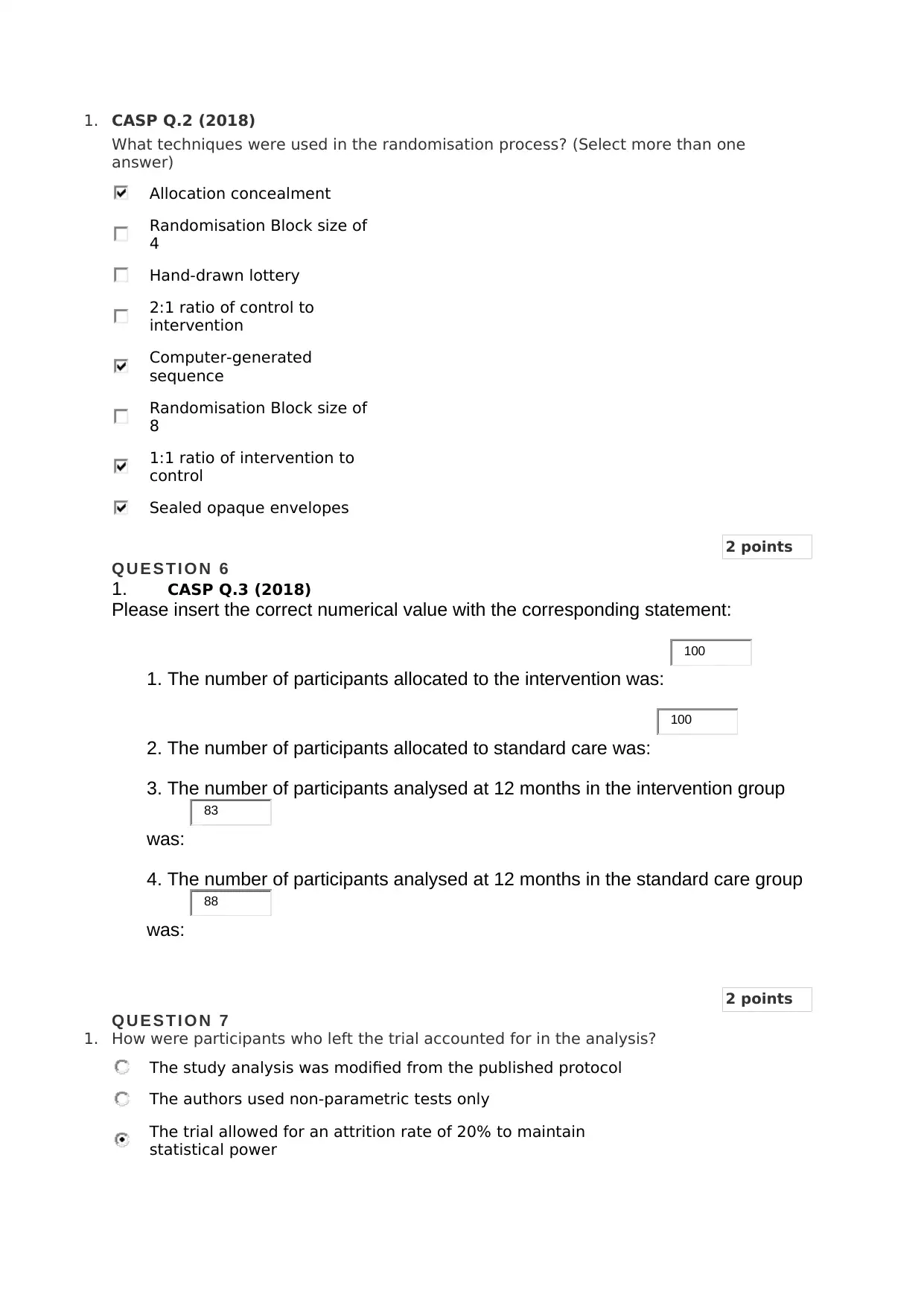
1. CASP Q.2 (2018)
What techniques were used in the randomisation process? (Select more than one
answer)
Allocation concealment
Randomisation Block size of
4
Hand-drawn lottery
2:1 ratio of control to
intervention
Computer-generated
sequence
Randomisation Block size of
8
1:1 ratio of intervention to
control
Sealed opaque envelopes
2 points
Q U E S T I O N 6
1. CASP Q.3 (2018)
Please insert the correct numerical value with the corresponding statement:
1. The number of participants allocated to the intervention was:
2. The number of participants allocated to standard care was:
3. The number of participants analysed at 12 months in the intervention group
was:
4. The number of participants analysed at 12 months in the standard care group
was:
2 points
Q U E S T I O N 7
1. How were participants who left the trial accounted for in the analysis?
The study analysis was modified from the published protocol
The authors used non-parametric tests only
The trial allowed for an attrition rate of 20% to maintain
statistical power
100
100
83
88
What techniques were used in the randomisation process? (Select more than one
answer)
Allocation concealment
Randomisation Block size of
4
Hand-drawn lottery
2:1 ratio of control to
intervention
Computer-generated
sequence
Randomisation Block size of
8
1:1 ratio of intervention to
control
Sealed opaque envelopes
2 points
Q U E S T I O N 6
1. CASP Q.3 (2018)
Please insert the correct numerical value with the corresponding statement:
1. The number of participants allocated to the intervention was:
2. The number of participants allocated to standard care was:
3. The number of participants analysed at 12 months in the intervention group
was:
4. The number of participants analysed at 12 months in the standard care group
was:
2 points
Q U E S T I O N 7
1. How were participants who left the trial accounted for in the analysis?
The study analysis was modified from the published protocol
The authors used non-parametric tests only
The trial allowed for an attrition rate of 20% to maintain
statistical power
100
100
83
88
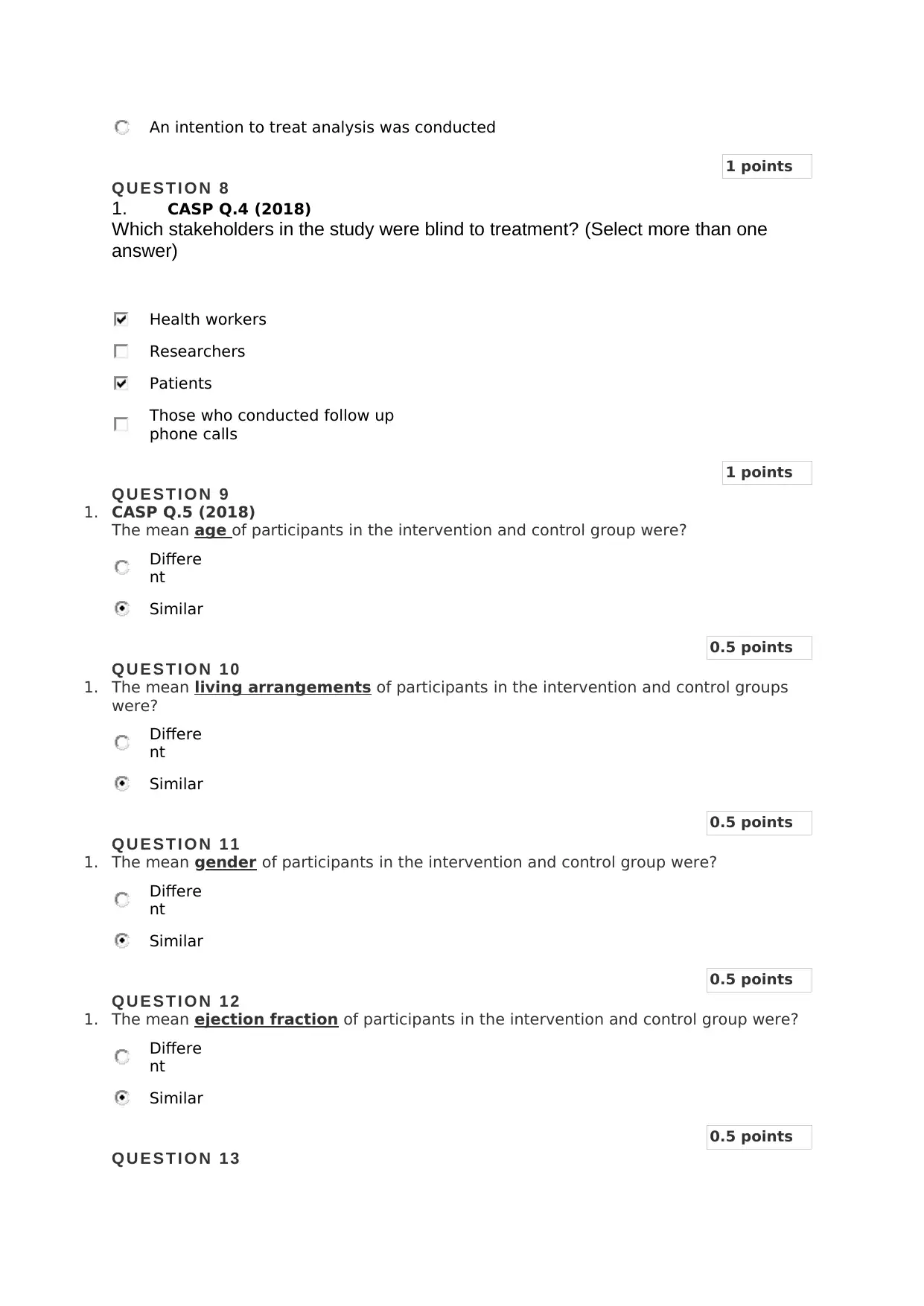
An intention to treat analysis was conducted
1 points
Q U E S T I O N 8
1. CASP Q.4 (2018)
Which stakeholders in the study were blind to treatment? (Select more than one
answer)
Health workers
Researchers
Patients
Those who conducted follow up
phone calls
1 points
Q U E S T I O N 9
1. CASP Q.5 (2018)
The mean age of participants in the intervention and control group were?
Differe
nt
Similar
0.5 points
Q U E S T I O N 1 0
1. The mean living arrangements of participants in the intervention and control groups
were?
Differe
nt
Similar
0.5 points
Q U E S T I O N 1 1
1. The mean gender of participants in the intervention and control group were?
Differe
nt
Similar
0.5 points
Q U E S T I O N 1 2
1. The mean ejection fraction of participants in the intervention and control group were?
Differe
nt
Similar
0.5 points
Q U E S T I O N 1 3
1 points
Q U E S T I O N 8
1. CASP Q.4 (2018)
Which stakeholders in the study were blind to treatment? (Select more than one
answer)
Health workers
Researchers
Patients
Those who conducted follow up
phone calls
1 points
Q U E S T I O N 9
1. CASP Q.5 (2018)
The mean age of participants in the intervention and control group were?
Differe
nt
Similar
0.5 points
Q U E S T I O N 1 0
1. The mean living arrangements of participants in the intervention and control groups
were?
Differe
nt
Similar
0.5 points
Q U E S T I O N 1 1
1. The mean gender of participants in the intervention and control group were?
Differe
nt
Similar
0.5 points
Q U E S T I O N 1 2
1. The mean ejection fraction of participants in the intervention and control group were?
Differe
nt
Similar
0.5 points
Q U E S T I O N 1 3
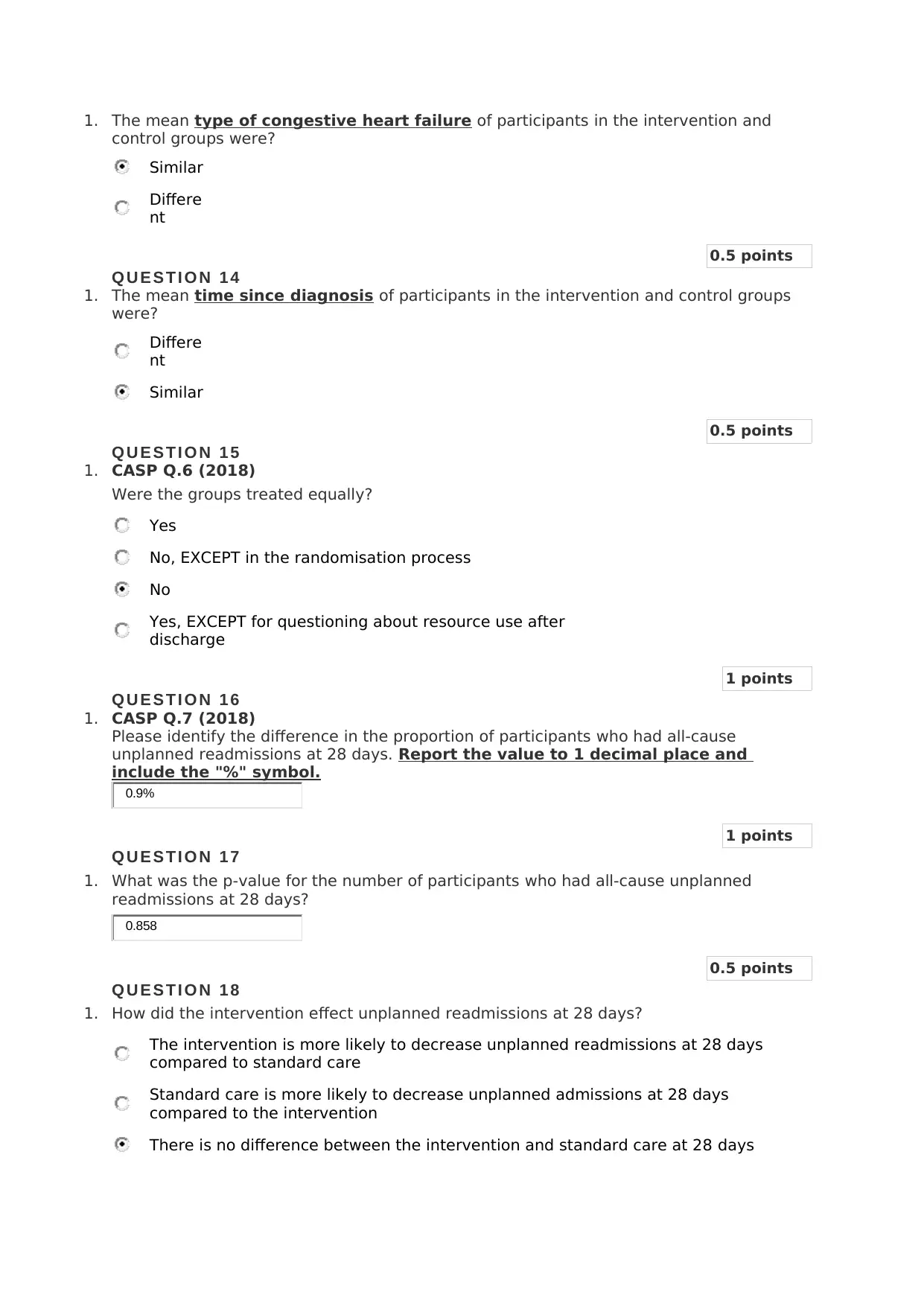
1. The mean type of congestive heart failure of participants in the intervention and
control groups were?
Similar
Differe
nt
0.5 points
Q U E S T I O N 1 4
1. The mean time since diagnosis of participants in the intervention and control groups
were?
Differe
nt
Similar
0.5 points
Q U E S T I O N 1 5
1. CASP Q.6 (2018)
Were the groups treated equally?
Yes
No, EXCEPT in the randomisation process
No
Yes, EXCEPT for questioning about resource use after
discharge
1 points
Q U E S T I O N 1 6
1. CASP Q.7 (2018)
Please identify the difference in the proportion of participants who had all-cause
unplanned readmissions at 28 days. Report the value to 1 decimal place and
include the "%" symbol.
1 points
Q U E S T I O N 1 7
1. What was the p-value for the number of participants who had all-cause unplanned
readmissions at 28 days?
0.5 points
Q U E S T I O N 1 8
1. How did the intervention effect unplanned readmissions at 28 days?
The intervention is more likely to decrease unplanned readmissions at 28 days
compared to standard care
Standard care is more likely to decrease unplanned admissions at 28 days
compared to the intervention
There is no difference between the intervention and standard care at 28 days
0.9%
0.858
control groups were?
Similar
Differe
nt
0.5 points
Q U E S T I O N 1 4
1. The mean time since diagnosis of participants in the intervention and control groups
were?
Differe
nt
Similar
0.5 points
Q U E S T I O N 1 5
1. CASP Q.6 (2018)
Were the groups treated equally?
Yes
No, EXCEPT in the randomisation process
No
Yes, EXCEPT for questioning about resource use after
discharge
1 points
Q U E S T I O N 1 6
1. CASP Q.7 (2018)
Please identify the difference in the proportion of participants who had all-cause
unplanned readmissions at 28 days. Report the value to 1 decimal place and
include the "%" symbol.
1 points
Q U E S T I O N 1 7
1. What was the p-value for the number of participants who had all-cause unplanned
readmissions at 28 days?
0.5 points
Q U E S T I O N 1 8
1. How did the intervention effect unplanned readmissions at 28 days?
The intervention is more likely to decrease unplanned readmissions at 28 days
compared to standard care
Standard care is more likely to decrease unplanned admissions at 28 days
compared to the intervention
There is no difference between the intervention and standard care at 28 days
0.9%
0.858
Secure Best Marks with AI Grader
Need help grading? Try our AI Grader for instant feedback on your assignments.
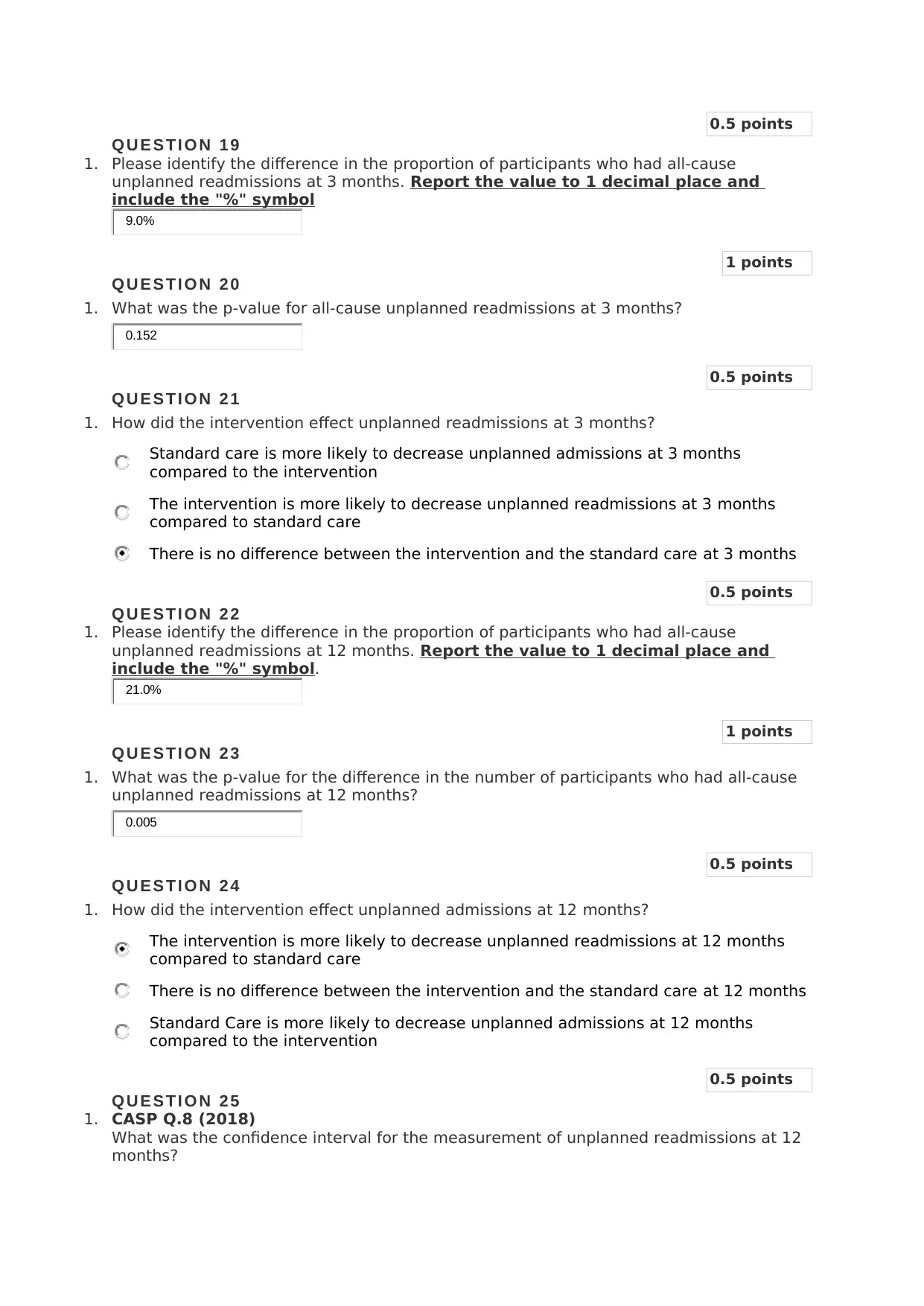
0.5 points
Q U E S T I O N 1 9
1. Please identify the difference in the proportion of participants who had all-cause
unplanned readmissions at 3 months. Report the value to 1 decimal place and
include the "%" symbol
1 points
Q U E S T I O N 2 0
1. What was the p-value for all-cause unplanned readmissions at 3 months?
0.5 points
Q U E S T I O N 2 1
1. How did the intervention effect unplanned readmissions at 3 months?
Standard care is more likely to decrease unplanned admissions at 3 months
compared to the intervention
The intervention is more likely to decrease unplanned readmissions at 3 months
compared to standard care
There is no difference between the intervention and the standard care at 3 months
0.5 points
Q U E S T I O N 2 2
1. Please identify the difference in the proportion of participants who had all-cause
unplanned readmissions at 12 months. Report the value to 1 decimal place and
include the "%" symbol.
1 points
Q U E S T I O N 2 3
1. What was the p-value for the difference in the number of participants who had all-cause
unplanned readmissions at 12 months?
0.5 points
Q U E S T I O N 2 4
1. How did the intervention effect unplanned admissions at 12 months?
The intervention is more likely to decrease unplanned readmissions at 12 months
compared to standard care
There is no difference between the intervention and the standard care at 12 months
Standard Care is more likely to decrease unplanned admissions at 12 months
compared to the intervention
0.5 points
Q U E S T I O N 2 5
1. CASP Q.8 (2018)
What was the confidence interval for the measurement of unplanned readmissions at 12
months?
9.0%
0.152
21.0%
0.005
Q U E S T I O N 1 9
1. Please identify the difference in the proportion of participants who had all-cause
unplanned readmissions at 3 months. Report the value to 1 decimal place and
include the "%" symbol
1 points
Q U E S T I O N 2 0
1. What was the p-value for all-cause unplanned readmissions at 3 months?
0.5 points
Q U E S T I O N 2 1
1. How did the intervention effect unplanned readmissions at 3 months?
Standard care is more likely to decrease unplanned admissions at 3 months
compared to the intervention
The intervention is more likely to decrease unplanned readmissions at 3 months
compared to standard care
There is no difference between the intervention and the standard care at 3 months
0.5 points
Q U E S T I O N 2 2
1. Please identify the difference in the proportion of participants who had all-cause
unplanned readmissions at 12 months. Report the value to 1 decimal place and
include the "%" symbol.
1 points
Q U E S T I O N 2 3
1. What was the p-value for the difference in the number of participants who had all-cause
unplanned readmissions at 12 months?
0.5 points
Q U E S T I O N 2 4
1. How did the intervention effect unplanned admissions at 12 months?
The intervention is more likely to decrease unplanned readmissions at 12 months
compared to standard care
There is no difference between the intervention and the standard care at 12 months
Standard Care is more likely to decrease unplanned admissions at 12 months
compared to the intervention
0.5 points
Q U E S T I O N 2 5
1. CASP Q.8 (2018)
What was the confidence interval for the measurement of unplanned readmissions at 12
months?
9.0%
0.152
21.0%
0.005
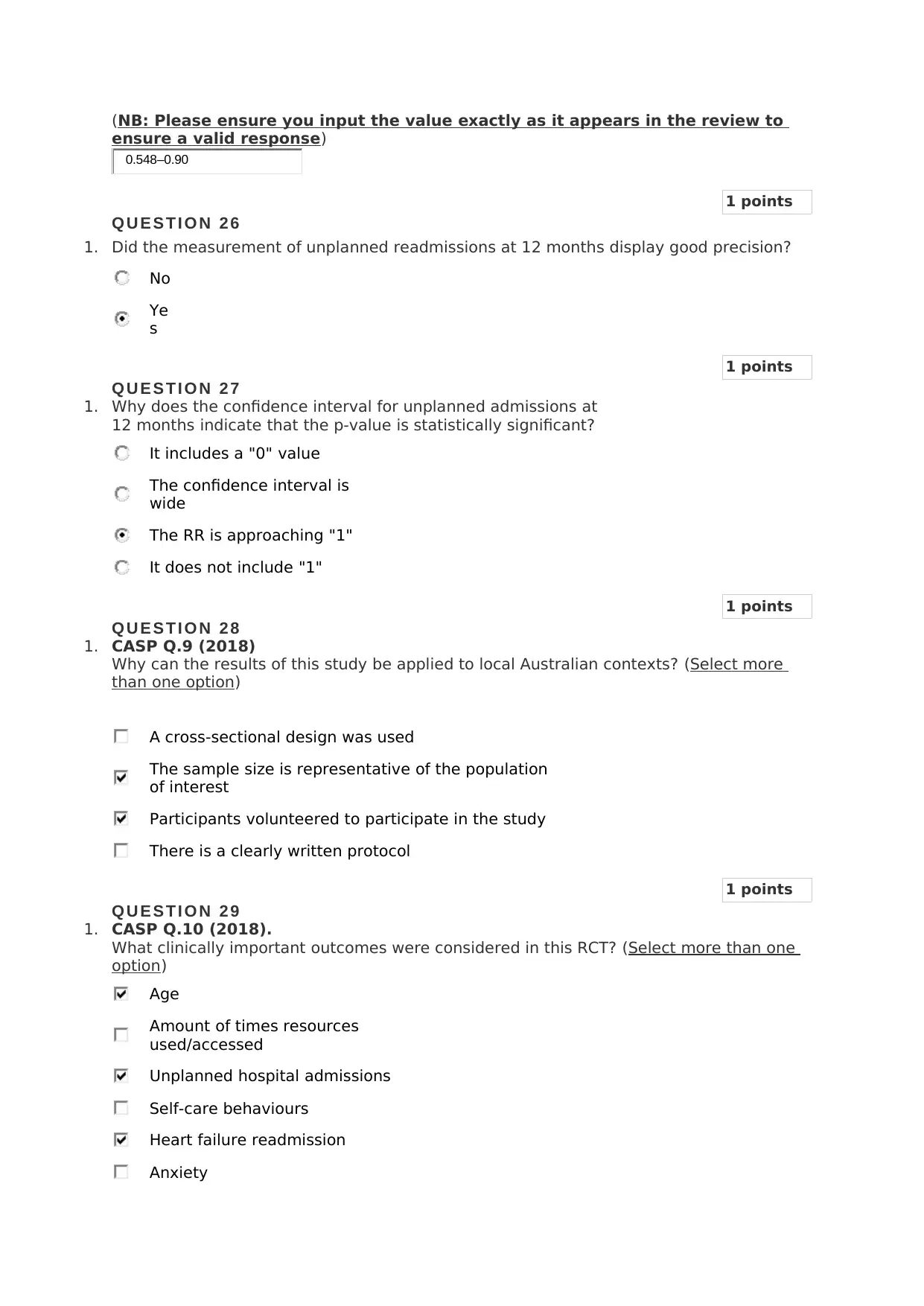
(NB: Please ensure you input the value exactly as it appears in the review to
ensure a valid response)
1 points
Q U E S T I O N 2 6
1. Did the measurement of unplanned readmissions at 12 months display good precision?
No
Ye
s
1 points
Q U E S T I O N 2 7
1. Why does the confidence interval for unplanned admissions at
12 months indicate that the p-value is statistically significant?
It includes a "0" value
The confidence interval is
wide
The RR is approaching "1"
It does not include "1"
1 points
Q U E S T I O N 2 8
1. CASP Q.9 (2018)
Why can the results of this study be applied to local Australian contexts? (Select more
than one option)
A cross-sectional design was used
The sample size is representative of the population
of interest
Participants volunteered to participate in the study
There is a clearly written protocol
1 points
Q U E S T I O N 2 9
1. CASP Q.10 (2018).
What clinically important outcomes were considered in this RCT? (Select more than one
option)
Age
Amount of times resources
used/accessed
Unplanned hospital admissions
Self-care behaviours
Heart failure readmission
Anxiety
0.548–0.90
ensure a valid response)
1 points
Q U E S T I O N 2 6
1. Did the measurement of unplanned readmissions at 12 months display good precision?
No
Ye
s
1 points
Q U E S T I O N 2 7
1. Why does the confidence interval for unplanned admissions at
12 months indicate that the p-value is statistically significant?
It includes a "0" value
The confidence interval is
wide
The RR is approaching "1"
It does not include "1"
1 points
Q U E S T I O N 2 8
1. CASP Q.9 (2018)
Why can the results of this study be applied to local Australian contexts? (Select more
than one option)
A cross-sectional design was used
The sample size is representative of the population
of interest
Participants volunteered to participate in the study
There is a clearly written protocol
1 points
Q U E S T I O N 2 9
1. CASP Q.10 (2018).
What clinically important outcomes were considered in this RCT? (Select more than one
option)
Age
Amount of times resources
used/accessed
Unplanned hospital admissions
Self-care behaviours
Heart failure readmission
Anxiety
0.548–0.90
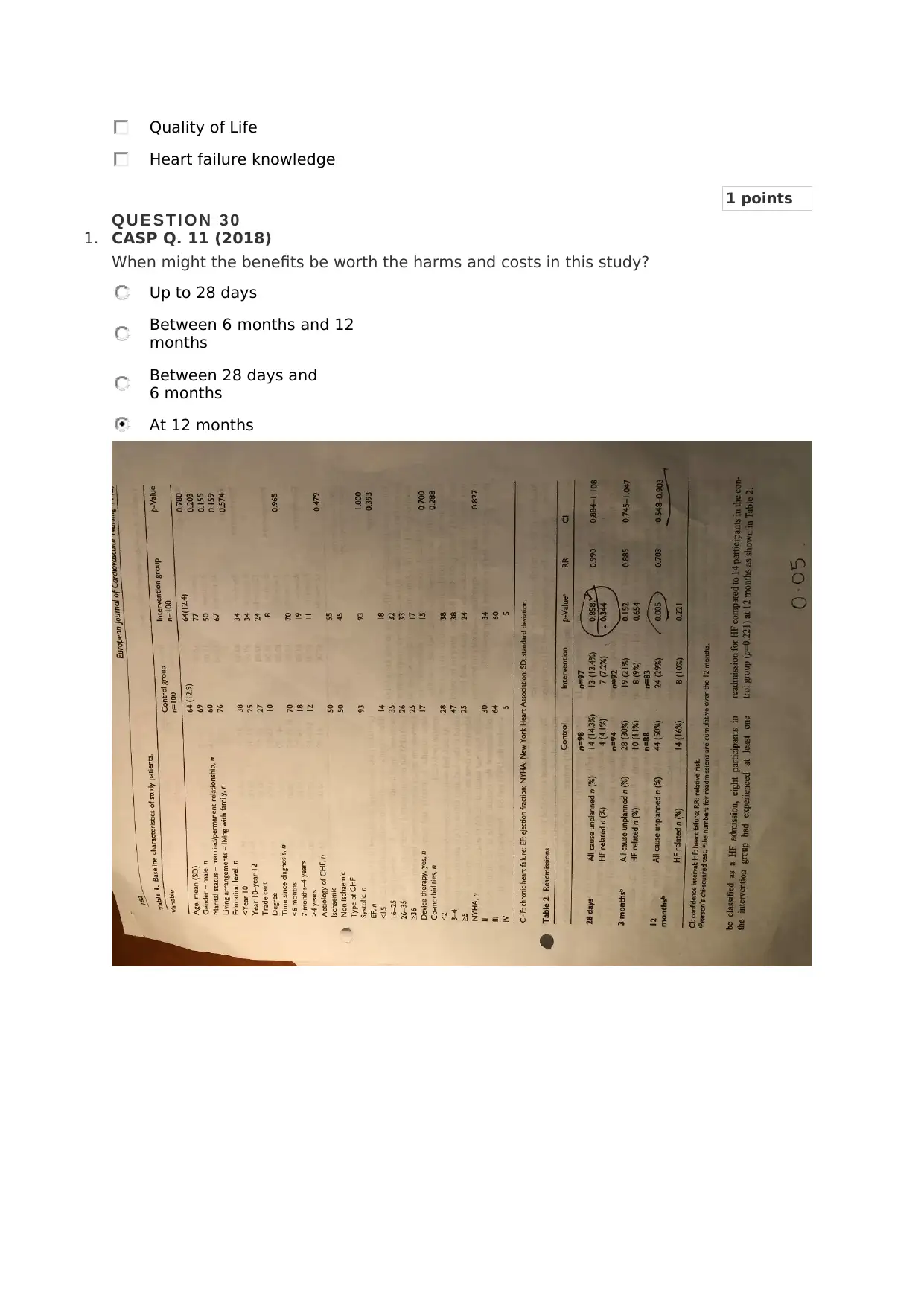
Quality of Life
Heart failure knowledge
1 points
Q U E S T I O N 3 0
1. CASP Q. 11 (2018)
When might the benefits be worth the harms and costs in this study?
Up to 28 days
Between 6 months and 12
months
Between 28 days and
6 months
At 12 months
Heart failure knowledge
1 points
Q U E S T I O N 3 0
1. CASP Q. 11 (2018)
When might the benefits be worth the harms and costs in this study?
Up to 28 days
Between 6 months and 12
months
Between 28 days and
6 months
At 12 months
1 out of 7
Your All-in-One AI-Powered Toolkit for Academic Success.
+13062052269
info@desklib.com
Available 24*7 on WhatsApp / Email
![[object Object]](/_next/static/media/star-bottom.7253800d.svg)
Unlock your academic potential
© 2024 | Zucol Services PVT LTD | All rights reserved.


